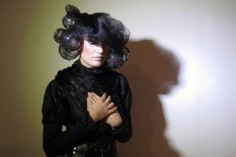KOBAKANT
The Crying Dress
source: interactiondesign
KOBAKANT is a collaboration between Mika Satomi and Hannah Perner-Wilson. Hannah came to Umeå/UID during SIDeR 2010 and ran a workshop Handcrafting a textile sensor from scratch. I just found out the online repository where Mika and her provide an absolutely amazing documentation about wearable technology.
.
.
.
.
.
.
.
source: fashioningtech
When we think of wearables, we tend to associate futuristic streamlined shapes, innovative and synthetic materials, and sports or body enhancing technologies. Rarely do we envision the poetry of the combination of craft and narrative to bring wearable technologies alive, and emotionally vibrant. Kobakant’s recent project, “The Crying Dress,” is made for a speculative future where crafts are highly valued, and widows are bequest dresses which may cry for them. The design is Kobakant’s first foray into fashion, where previous projects saw them honing their craft and DIY e-textile skills. It is interesting to note how Kobakant foregrounds the importance of context, story telling, and of imaginative expectations of the future of wearables which are incumbent on the re-valuing of hand-skills over the machine made. “The Crying Dress” is exquisitely poignant and melancholic, suitable for a distant future that is sure to reawakens the past.
.
.
.
.
.
.
.
source: kobakantat
In 2020, the global economy is in shambles. Localized production and craftsmanship experiences it’s first major boom since it’s decline preceding the 1920′s Industrial Revolution. The electronics sector in particular is hit by a scarcity of resources, causing prices to skyrocket. Electronics, previously known for their uniformity and quantity, almost overnight become a showcase for individuality, materiality and skilled labor. This development is now commonly known as Exquisite Electronics and today we live in a world where the rich commission extravagant Haute Couture electronics reminiscent of pre-industrial eras. In 2028, the artisans KOBAKANT were commissioned to make an Extravagant Electronic funeral gown, also known as The Crying Dress. The gown was worn by the wife of the deceased commissioner in attendance of his funeral, where the dress shed endless tears of mourning. There has been much speculation on the commissioner’s motivation for ordering the gown prior to his death, but it is widely believed that he intended for it to console his wife and accompany her mourning.


